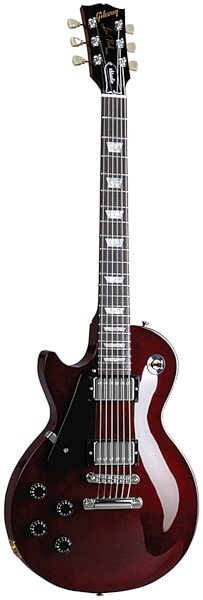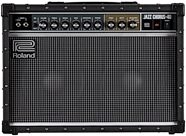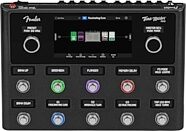Gibson Left-Handed Les Paul Studio Electric Guitar (with Case)
No longer available at zZounds

The Gibson Left-Handed Les Paul Studio is a southpaw-friendly classic. With a '50s rounded neck and chambered body, the lefty Gibson Les Paul Studio rocks.
Overview
The Gibson Left-Handed Les Paul Studio offers traditional Les Paul performance with a modern, no-frills attitude. Introduced nearly 25 years ago as a guitar for the studio musician, the Left-Handed Les Paul Studio has become one of the most desired lefty Les Pauls for its tremendous harmonic and sonic capacities, coveted by musicians from all genres of music.
Angled Headstock
The Gibson Left-Handed Les Paul Studio's angled headstock is another example of Gibson's industry-changing way of thinking. Every Gibson headstock is carved out of the same piece of mahogany as the neck then fitted with Gibson's traditional wing blocks. It is not a "glued-on" headstock, and the process takes craftsmanship, time, and effort. But the rewards are worth the effort. The headstock is carefully angled at 17 degrees, which increases pressure on the strings and helps them stay in the nut slots. An increase in string pressure also means there is no loss of string vibration between the nut and the tuners, which equals better sustain for your Left-Handed Les Paul Studio.Adjustable Truss Rod
The adjustable truss rod is a Gibson innovation that revolutionized the guitar. Before this ground-breaking discovery in the early 1920s, the truss rod was used only to strengthen and stabilize the neck. By making it adjustable, the truss rod now allows the Gibson Left-Handed Les Paul Studio to be set up using a variety of string gauges, as well as string heights. This easily accommodates any style of… read more playing, and allows a limitless range of set-up options. And by placing it at the base of the headstock, the adjustable nut is easily accessible, even while the strings are still on the guitar.'50s Rounded Neck Profile
No guitar neck profiles are more distinguishable than the neck profiles employed on the Gibson models of today. The more traditional '50s neck profile-found on the Left-Handed Les Paul Studio-is the thicker, rounder profile, emulating the neck shapes of the iconic 1958 and 1959 Les Paul Standards. The Left-Handed Les Paul Studio's neck is machined in Gibson's rough mill using wood shapers to make the initial cuts. But once the fingerboard gets glued on, the rest-including the final sanding-is done by hand. That means there are no two necks with the exact same dimensions. So while it still has the basic characteristics of its respective profile, each neck will be slightly different, with a distinct but traditional feel.22-Fret Rosewood Fingerboard
Both rosewood and ebony have always graced the fingerboards of the world's finest stringed instruments, including many of today's Gibsons. The fingerboards on the Gibson Left-Handed Les Paul Studio are constructed from the highest grade rosewood and ebony on the planet. Both are personally inspected and qualified by Gibson's team of skilled wood experts before they enter the factories to be fitted onto the neck of the Left-Handed Les Paul Studio. The resilience of these dense and durable woods makes these fingerboards extremely balanced and stable, and gives each chord and note unparalleled clarity and bite. The 12-inch radius of the fingerboard provides smooth note bending capabilities and eliminates "dead" or "choked out" notes, common occurrences on fingerboards with lesser radiuses. The ebony fingerboard is only available on the Les Paul Studios in Classic White or Alpine White. The Rosewood fingerboard is only available on the Studios in Ebony, Wine Red, and Fireburst.Trapezoid Inlays
The classic trapezoid inlay is one of the most distinguishable features of many traditional Gibson models, including the Left-Handed Les Paul Studio. A figured, swirl acrylic gives these inlays that classic "pearl" look. They are inserted into the fingerboard using a process that eliminates gaps and doesn't require the use of fillers.Set-Neck Construction
Like all classic Gibson guitars, the necks on the Left-Handed Les Paul Studios are distinguished by one of the more traditional features that have always set them apart-a glued neck joint. Gluing the neck to the body of the guitar ensures a "wood-to-wood" contact, no air space in the neck cavity, and maximum contact between the neck and body, allowing the neck and body to function as a single unit. The result? Better tone, better sustain, and no loose or misaligned necks.Mahogany Back and Maple Top
There isn't anything more critical than the marriage of the Les Paul's mahogany back with a maple cap, as well as the regimen involved in selecting the right wood and the formula to dry it out. First, the wood is personally inspected and qualified by Gibson's team of skilled wood experts before it enters the Gibson factories. These onsite inspectors also ensure that the plain maple comes from corporations adhering to the forest-saving standards of the Rainforest Alliance, of which Gibson is a proud member and sponsor. Inside the Gibson factories, humidity is maintained at 45 percent, and the temperature at 70 degrees. This ensures all woods are dried to a level of "equilibrium," where the moisture content does not change during the manufacturing process. This guarantees tight-fitting joints and no expansion, and controls the shrinkage and warping of the woods, in addition to reducing the weight. It also improves the woods' machinability and finishing properties, and adherence to glue. Consistent moisture content means that a Gibson guitar will respond evenly to temperature and humidity changes long after it leaves the factory.Chambered Body
There's something about playing a guitar with perfect tone, balance, and weight. One of the ways the expert craftsmen at Gibson USA achieve this equilibrium is by carving carefully mapped-out chambers in the Les Paul's solid mahogany back using a Computer Numeric Controlled (CNC) router before the maple top is glued on. The positioning of the routes was established after careful examination of the resonant characteristics of the Les Paul. Gibson approached this process with the awareness that every change to the formula would have repercussions on the instrument's sound. So, in addition to relieving the stress on a player's back and shoulder, these lighter Gibson guitars also enhance the tone palette in a manner unique only to these guitars. The results are comfortable, lightweight guitars that are acoustically louder, with increased sustain and resonance.490R and 498T Pickups
The mid to late 1960s saw the emergence of a very different type of music coming from the clubs of England. It was an interpretation of the blues that hadn't been heard before, and it was much harder, more rocking, and definitely louder than anything else before it. As such, this genre's players were demanding more powerful amplifiers with increased volume outputs to satisfy their sonic explorations. This led to a call for a more versatile pickup to split coils through a push/pull knob, and prevent the microphonic feedback that occurs when the volume is turned up to maximum levels. Gibson answered this call with the introduction of the revolutionary 490T and 490R pickups ("T" for treble, and "R" for rhythm), which has the traditional characteristics of the original "Patent Applied For" pickups, but with two key modifications. First, a four-conductor wiring scheme allows the 490s to be connected to any push/pull knob, which lets players split the coils and increase versatility. Gibson also introduced wax potting, which does away with any air space inside the pickup-thus lessening the chances of microphonic feedback. The result is a humbucker with the tonal characteristics of an original PAF, with a slight increase in upper mid-range response. The Gibson 498T bridge pickup is the 490's ideal complement. Taking the 490 one step further, the 498 swaps the Alnico II magnet to an Alnico V, thus making it slightly hotter with emphasis on mid-ranges and highs. The pole pieces on the 498T are also aligned a little further apart to accommodate the spacing of the strings at the bridge, which is different than the spacing of the strings at the neck.Nitrocellulose Finish
Applying a nitrocellulose finish to any Gibson guitar-including the Les Paul Studio-is one of the most labor-intensive elements of the guitar-making process. A properly applied nitro finish requires extensive man hours, several evenly applied coats, and an exorbitant amount of drying time. But this fact has never swayed Gibson into changing this time-tested method, employed ever since the first guitar was swathed with lacquer back in 1894. Why? For starters, a nitro finish dries to a much thinner coat than a polyurethane finish, which means there is less interference with the natural vibration of the instrument, allowing for a purer tone. A nitro finish is also a softer finish, which makes it easily repairable. You can touch up a scratch or ding on a nitro finish, but you can't do the same on a poly finish. In addition, a nitro finish is very porous in nature, and actually gets thinner over time. It does not "seal" wood in an airtight shell-as a poly finish does-and allows the wood to breathe and age properly. read lessSpecs
- Top: Carved maple top
- Back: Mahogany
- Neck: Mahogany
- Neck Profile: 59 Rounded
- Peghead Pitch: 17 degrees
- Thickness at 1st fret: 0.818 inches
- Thickness at 12th fret: 0.963 inches
- Heel Length: 5/8 inch
- Neck Joint Location: 16th fret
- Fingerboard: Rosewood
- Scale length: 24-3/4 inches
- Total Length: 18.062 inches
- Nut Width: 1-11/16 inches
- Width at 12th fret: 2.062 inches
- Frets: 22
- Inlays: Pearloid trapezoid
- Hardware Color: Gold
- Bridge: Tune-o-matic
- Tailpiece: Stopbar
- Knobs: Black Speed
- Tuners: Green Key
- Neck Pickup: 490R Alnico magnet humbucker
- Bridge Pickup: 498T Alnico magnet humbucker
- Controls: Two volume, two tone, three-way switch
Case:
- Exterior: Black Reptile Pattern Hardshell
- Interior: Dark Grey Plush with Black Shroud
- Silkscreen: Silver Gibson USA logo
Strings: .010-.046; Brite Wires
- Back: Mahogany
- Neck: Mahogany
- Neck Profile: 59 Rounded
- Peghead Pitch: 17 degrees
- Thickness at 1st fret: 0.818 inches
- Thickness at 12th fret: 0.963 inches
- Heel Length: 5/8 inch
- Neck Joint Location: 16th fret
- Fingerboard: Rosewood
- Scale length: 24-3/4 inches
- Total Length: 18.062 inches
- Nut Width: 1-11/16 inches
- Width at 12th fret: 2.062 inches
- Frets: 22
- Inlays: Pearloid trapezoid
- Hardware Color: Gold
- Bridge: Tune-o-matic
- Tailpiece: Stopbar
- Knobs: Black Speed
- Tuners: Green Key
- Neck Pickup: 490R Alnico magnet humbucker
- Bridge Pickup: 498T Alnico magnet humbucker
- Controls: Two volume, two tone, three-way switch
Case:
- Exterior: Black Reptile Pattern Hardshell
- Interior: Dark Grey Plush with Black Shroud
- Silkscreen: Silver Gibson USA logo
Strings: .010-.046; Brite Wires
No longer available at zZounds
In most cases, a product is unavailable because it has been discontinued by the manufacturer
This is a carousel with product cards. Use the previous and next buttons to navigate.
Cases and Bags
This is a carousel with product cards. Use the previous and next buttons to navigate.
Cases and Bags
This is a carousel with product cards. Use the previous and next buttons to navigate.












